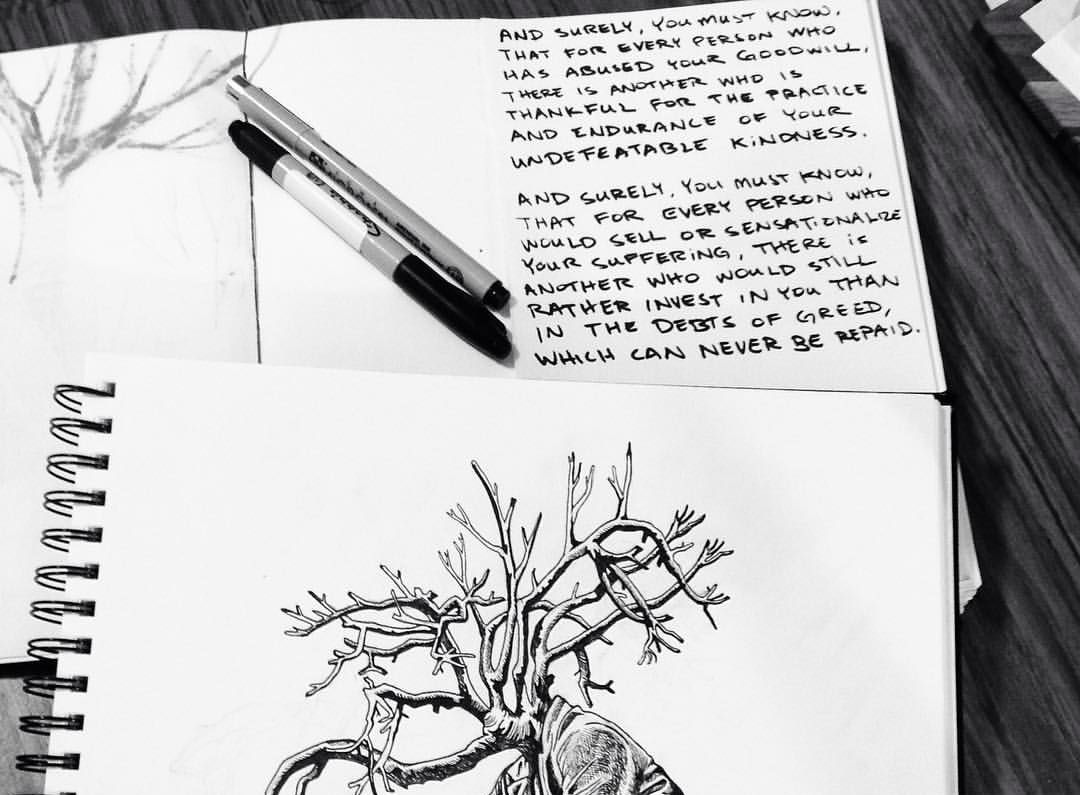Why art for charity hurts the people who create it.
This article was first published by Tone Madison, who helped sponsor my research.
The holidays. The season of giving. The season of fundraising.
Every year, and especially this time of year, organizations ask artists to donate their time and art to help raise money for a variety of causes.
As an artist who works frequently with nonprofits and mission-focused businesses, I understand the desire to help an admirable mission. I also understand the need for fundraising, to close social gaps and increase investment in underfunded areas.
But the reality is that charitable causes often put artists in a hard spot.
Only 2.3 percent of established artists make significant income from their art, and only 1 percent make a full-time living from it1. The average artist’s business brings in a gross revenue of $40,0001. The median American wage is $61,3002 not including benefits. The institutions that typically ask artists for donations of their time and artwork, like charitable foundations and trusts, pay their median employee $61,000. The disparities grow from there.
We are a society that asks a person with one candy bar to give half of that candy bar to someone with 1,000 candy bars. The power balance is lopsided between artists and institutions, between artists and potential donors and patrons. The design of our fundraisers often puts too little of the responsibility on institutions and people in power, and too much on the powerless individuals whom social causes are supposedly helping. This isn’t a matter of opinion or perception. It’s literally written into our laws.
At the root of the issue is taxation, and specifically, who gets taxed for what. Delve into the nitty-gritty of our tax code, and it’s easy to see how interactions between artists and charitable institutions have become so perverse. Here’s the breakdown.
Donations and Taxes: Who Gets a Tax Deduction?
- Tax laws favor donors and tax -exempt institutions. All cash donations, as long as they are properly documented and apply to the current fiscal year, are tax-deductible.3 Cash donations must be given to a documented, tax-exempt organization.
- Non-cash donations are also tax-deductible. For example, if an art collector donates a work of art to a charity or nonprofit, they can deduct the full value of that artwork from their taxes. Non-cash donations of more than $5,000 require a written appraisal of the work’s value, but as long as a donor finds an appraiser, then there is no limit to what they can donate—and deduct.3
- But donations are not tax-deductible if they are given directly to an individual. This is why people generally don’t give directly to the homeless or those in need, regardless of how deserving a given individual might be. By law, they must give to a tax-exempt organization in order to receive a tax deduction.3
- Donating your time is not a tax deduction.4 However, corporations donating the time of employees can deduct their employees’ payroll. In other words, if you are an artist and asked to donate your time by creating a painting for a fundraiser or give a live art demo for free, you cannot deduct your time, only your materials. But if you own a corporation and one of your employees volunteers for an event, the corporation can take a tax deduction since all employee salaries, wages, commissions, bonuses, etc. are tax deductible.
- Artists can only deduct the material costs of a donated artwork, not the labor or the full sales value of the artwork, even if they are registered as a business.
- Collectors, on the other hand, may deduct the full value of an artwork they have purchased, because an artwork in their collection is considered capital gains property and an asset.5
- Similarly, when an artist dies and their artwork goes to an heir or estate, that estate is now allowed to donate the full value of the artwork. This is why so many museums and collections favor the artwork of dead artists.6 The tax system is not set up to benefit living artists, but rather to extract value from the ones who are already deceased. The old joke that “You’ll only be famous when you’re dead” isn’t an accident. It is the product of our laws and systems.
- It isn’t all roses for the museums and institutions that accept large donations of artwork and antiques, either. These institutions become permanently responsible for caring for and maintaining these collections with climate-controlled buildings, (often underpaid) staff, and materials to repair damaged pieces. How do they pay for this maintenance? With public tax dollars, grants, and donations. In other words, a donor could potentially unload a large, expensive collection on a museum to maintain, take a tax deduction for the value of the collection, and therefore not pay into the tax system that supports the museum and enables it to exist. That tax burden moves from the donor to the rest of the tax base.
- Americans volunteer $193 billion of their time per year to charity.7 To put that into perspective, Jeff Bezos at his richest was worth $168 billion.8 Considering that the median freelance artist makes $40,000 through their business and out of that takes a $17,000 wage1, we should probably stop asking artists to volunteer their non-tax-deductible time.
Charitable Giving: Who’s Giving, and How Much?
- Americans gave $410.02 billion to charity in 2017.7 Of that total, corporations gave $20.77 billion, foundations gave $66.9 billion, and individuals gave $286.65 billion, or 70% of total giving.
- High net worth individuals (median $2,000,000) give on average $29,269 annually to charity. The general population gives $2,514.9
- Grantmaking foundations and charitable trusts represent a $138.8 billion industry and have grown at a rate of 5 percent in the last five years. 56.2 percent of their revenue comes from private contributions, gifts, and grants. 13.3 percent comes from assets sold, which equates to $18.46 billion in revenue.10 This includes revenue from items sold in auction, like artwork.
- Overall, charitable giving is growing at a rate of 5 percent per year. Meanwhile, the richest 1 percent of the population grows wealth at a rate of 6 percent per year, compared to a rate of 3 percent for everyone else. The US House of Representatives passed a $3.8 trillion tax cut in 2018,11 following the 2017 bill of $1.5 trillion. The 1 percent are on track to control two-thirds of the world’s wealth by 2030.12 The need for charity continues to grow.
Bucky on Parade: The Thing No One Has Talked About
Love ‘em or hate ‘em, Bucky on Parade13 got people talking. Some people were obsessed with the program’s 85 Bucky Badger sculptures and hunted them like Pokemon Go. A bunch of renegades started taking naked pictures with them. Tone Madison’s Scott Gordon and other commentators14 and artists lambasted them as a sad excuse for public art, and were met in turn by Bucky defenders telling them to sod off, it’s for a good cause.
In the midst of all of the debate, the love and the hate, did anyone remember the artists? By the end of this project, everyone knew about Bucky on Parade and the 85 Buckys around the city. Does anyone remember even half the names of the 64 artists who painted them?
If you ever wanted an example of how charitable causes that use the arts are almost never about the benefiting artists, the fact that almost no one remembers the names of the artists should make all of us pause. The Bucky brand (which wasn’t exactly suffering beforehand in Madison) got elevated. The artists largely disappeared.
Even so, there are likely readers who think this stance is too harsh, or who think of course it wasn’t about the artists, it was about the cancer fundraiser! It was about public health! Even so, can we make an argument for public health if part of driving the cause was unhealthy for the very people who made the fundraiser possible? Imagine people hunting for blank, white Buckys around Madison because no artists agreed to paint them. Would there have been half the same appeal? Here are some stats on what a bad deal this project was for the artists involved:
- Bucky on Parade13 (sponsored by the Madison Area Sports Commission) paid 64 artists to paint 85 Buckys for $1,500 per Bucky, spending a total of $127,500 on artists’ labor. They auctioned 32 of the statues to fundraise for Garding Against Cancer and raised more than $800,000 for the cause15. The average Bucky auctioned for approximately $25,000. This means artists were paid on average 6 percent of the final value of the Bucky, before taxes. This $800,000 figure does not include money raised through the sale of the other 53 Buckys or merchandise of the artists’ designs.13
- Artists, like all other paid contractors/self-employed people, pay self-employment tax16, which is double what employees pay for Social Security and Medicare. A self-employed artist’s combined federal, state, and other taxes equal about about 27 percent their annual revenue. So for every $1,500 stipend, an artist’s take-home pay is $1,095 minus what they spent on materials and transportation. All Bucky artists were responsible for paying to transport their own Buckys to and from their studios for the event.
- Garding Against Cancer is a nonprofit, meaning it’s a tax-exempt institution. So while the artists paid taxes on an already minimal amount of money, the nonprofit did not on the profits it gained from them. (Many people don’t realize that nonprofits are businesses. Nonprofits can, despite the term, turn a profit.) Donors who bought the Buckys also received a tax deduction, under the rules I explained above.
- Artists’ pay can be a dicey subject to bring up when it comes to fundraisers, because it isn’t about the art. It’s about the cause, and cancer is a poignant, personal one for many people. But cancer is a $107 billion industry worldwide17, growing 8 to 11 percent every year. With the average patient representing $300,000 of potential revenue, there is little incentive for this to change. The US accounts for 42.2 percent of spending on new cancer drugs18, which is one of the primary drivers of increased spending in the cancer industry. The US spent $99 per capita on cancer drugs in 2014, which in Wisconsin equates to approximately $560 million. It’s an entirely different debate whether this funding has even been effective in reducing cancer rates (it hasn’t). But it makes little sense for one of the least funded industries ($811,000 on the arts in Wisconsin)19 to be fundraising for one of the most well-funded industries by both private and public sectors. Public funding for the arts is 1/10th of 1 percent of public funding for cancer drugs. Tell me again who this fundraiser is for?
This isn’t to say that you shouldn’t donate to fundraisers or support charitable causes. Fundraisers and private donations remain an important part of serving our communities. With recent tax cuts for the wealthy, fundraising and charitable giving will only continue to grow to address increased need. But if you are willing to give to a charitable cause, then it is worth taking the time to be educated on how we choose to serve a mission.
In the long run, we need policy change in our taxes and laws, as well as a paradigm shift for how we view creative labor. In the short run, if you are going to ask artists to contribute to a fundraiser, add their labor as a billable item, like any other part of organizing an event. If you are paying for an event space, furniture rentals, lights, catering, etc., then you should be paying for artists’ labor, too. If you are using artists’ designs to elevate a cause, ask whether the cause elevates them as well, not just your brand. If you are asking them to donate art—just don’t. Ask an art collector instead, because they win either way. If you absolutely must ask an artist to donate, then pair them with a sponsor, give them a commission of the sales, and set a minimum bid so their art doesn’t get snagged on the cheap5 only for the buyer to turn around and resell it at market value or get it appraised and donated for a deduction (yes, that happens).
There are many ways in which nonprofits are successfully achieving their goals and addressing inequities. There are also many ways in which they are not successful and feeding into the problem. Much of that is designed into our systems and incentives, which have in turn shaped our thinking. If we are going to change this, then we must first change how we think.
This essay is a part of a series called Rethinking the Arts, about the challenges we face and what to do about them. Got questions or interested in a particular topic? Comments welcome.
Cover artwork by Jenie Gao.
Sources:
- IBISWorld 71151 Performers & Creative Artists in the US Industry Report
- US Census, Income, Poverty, and Health Insurance Coverage in the United States, 2017: https://www.census.gov/newsroom/press-releases/2018/income-poverty.html
- Forbes, 11 Tips for Making Your Charitable Donation Count on Your Taxes: https://www.forbes.com/sites/kellyphillipserb/2015/12/20/11-tips-for-making-your-charitable-donation-count-on-your-taxes/#69adfdf62060
- Department of Internal Revenue Service, Charitable Contributions: https://www.irs.gov/pub/irs-pdf/p526.pdf
- The New York Times, Donating Work for Charity Has Downsides for Artists: https://www.nytimes.com/2006/05/28/arts/design/28kino.html
- Hyperallergic, Why Can’t Artists Deduct Donated Artworks from Their Taxes? https://hyperallergic.com/285128/why-cant-artists-deduct-donated-artworks-from-their-taxes/
- National Philanthropic Trust, Charitable Giving Statistics: https://www.nptrust.org/philanthropic-resources/charitable-giving-statistics/
- CNBC: Here’s what it will take for Jeff Bezos to become the first trillionaire: https://www.cnbc.com/2018/09/04/heres-what-it-will-take-for-bezos-to-become-the-first-trillionaire.html
- US Trust, Study of High Net Worth Philanthropy: https://www.ustrust.com/articles/2018-us-trust-study-of-high-net-worth-philanthropy.html
- IBISWorld 81321 Donations, Grants, and Endowment in the US Industry Report
- Fortune, Under the Fog of Kavanaugh, House Passes $3.8 Trillion More in Tax Cuts: http://fortune.com/2018/09/28/house-3-8-trillion-tax-cut-passes/
- The Guardian, Richest 1% on target to own two-thirds of all wealth by 2030: https://www.theguardian.com/business/2018/apr/07/global-inequality-tipping-point-2030
- Bucky on Parade: https://buckyonparade.com/
- Tone Madison, So, we’re really doing this thing with the huge Bucky Badgers: https://www.tonemadison.com/articles/so-were-really-doing-this-thing-with-the-huge-bucky-badgers
- Wisconsin State Journal, Bucky on Parade Comes to An End in Finale Auction: https://madison.com/wsj/news/local/bucky-on-parade-comes-to-an-end-in-finale-auction/article_6c817581-b058-5306-9af8-d944ae478bb2.html
- Internal Revenue Service, Self-Employment Tax: https://www.irs.gov/businesses/small-businesses-self-employed/self-employment-tax-social-security-and-medicare-taxes
- What is the Cancer-Industrial Complex?: https://medium.com/the-cancer-industrial-complex/what-is-the-cancer-industrial-complex-a0076ff2ce4
- US News, Global Cancer Spending Reaches $100B: https://www.usnews.com/news/blogs/data-mine/2015/05/05/global-cancer-spending-reaches-100b
- Rethinking the Arts, Arts Spending in Wisconsin and the US: https://learningtosee.jenie.org/rethinking-the-arts-arts-spending-in-wisconsin/





Fantastic article Jenie. Thank you for writing this.